产品中心
当前位置:首页>产品中心Anti-mu Opioid receptor
货号: bs-3623R 基本售价: 1380.0 元 规格: 100ul
- 规格:100ul
- 价格:1380.00元
- 规格:200ul
- 价格:2200.00元
产品信息
- 产品编号
- bs-3623R
- 英文名称
- mu Opioid receptor
- 中文名称
- µ-型阿片受体抗体
- 别 名
- LMOR; MOR 1; mor; MOR1; Mu opiate receptor; mu type opioid receptor; Mu type opioid receptor MOR 1; muOR; Opioid receptor mu 1; Opioid receptor mu; OPRM; OPRM1; OPRM_HUMAN.

- Specific References (2) | bs-3623R has been referenced in 2 publications.[IF=3.36] Laureano, D. P., et al. "Intrauterine growth restriction modifies the hedonic response to sweet taste in newborn pups-role of the accumbal μ-opioid receptors." Neuroscience (2016). WB ; Rat.PubMed:26926962[IF=2.33] Wu, Jian, Peng Li, and Xiuying Wu. "The effect of chronic intermittent hypoxia on respiratory sensitivity to morphine in rats." Sleep and Breathing (2017): 1-7. WB ; Rat.PubMed:28050773
- 规格价格
- 100ul/1380元购买 200ul/2200元购买 大包装/询价
- 说 明 书
- 100ul 200ul
- 研究领域
- 免疫学 神经生物学 信号转导 转录调节因子 激酶和磷酸酶
- 抗体来源
- Rabbit
- 克隆类型
- Polyclonal
- 交叉反应
- Human, Mouse, Rat, Dog, Pig, Cow, Rabbit, Guinea Pig,
- 产品应用
- WB=1:500-2000 IHC-P=1:400-800 IHC-F=1:400-800 ICC=1:100-500 IF=1:100-500 (石蜡切片需做抗原修复)
not yet tested in other applications.
optimal dilutions/concentrations should be determined by the end user.
- 分 子 量
- 45kDa
- 细胞定位
- 细胞浆 细胞膜
- 性 状
- Lyophilized or Liquid
- 浓 度
- 1mg/ml
- 免 疫 原
- KLH conjugated synthetic peptide derived from human mu Opioid receptor:165-270/400
- 亚 型
- IgG
- 纯化方法
- affinity purified by Protein A
- 储 存 液
- 0.01M TBS(pH7.4) with 1% BSA, 0.03% Proclin300 and 50% Glycerol.
- 保存条件
- Store at -20 °C for one year. Avoid repeated freeze/thaw cycles. The lyophilized antibody is stable at room temperature for at least one month and for greater than a year when kept at -20°C. When reconstituted in sterile pH 7.4 0.01M PBS or diluent of antibody the antibody is stable for at least two weeks at 2-4 °C.
- PubMed
- PubMed
- 产品介绍
- background:
This gene encodes one of three opioid receptors. The mu opioid receptor is the principal target of endogenous opioid peptides and opioid analgesic agents such a s beta-endorphn and enkephalins. The NM_001008503.1:c.118A>G allele had been associated with opioid and alcohol addiction and variations in pain sensitivity but evidence is conflicting. Multiple transcript variants encoding different isoforms have been found for this gene. [provided by RefSeq, Jun 2012]
Function:
Receptor for endogenous opioids such as beta-endorphin and endomorphin. Agonist binding to the receptor induces coupling to an inactive GDP-bound heterotrimeric G-protein complex and subsequent exchange of GDP for GTP in the G-protein alpha subunit leading to dissociation of the G-protein complex with the free GTP-bound G-protein alpha and the G-protein beta-gamma dimer activating downstream cellular effectors. The agonist- and cell type-specific activity is predominantly coupled to pertussis toxin-sensitive G(i) and G(o) G alpha proteins, GNAI1, GNAI2, GNAI3 and GNAO1 isoforms Alpha-1 and Alpha-2, and to a lesser extend to pertussis toxin-insensitive G alpha proteins GNAZ and GNA15. They mediate an array of downstream cellular responses, including inhibition of adenylate cyclase activity and both N-type and L-type calcium channels, activation of inward rectifying potassium channels, mitogen-activated protein kinase (MAPK), phospholipase C (PLC), phosphoinositide/protein kinase (PKC), phosphoinositide 3-kinase (PI3K) and regulation of NF-kappa-B. Also couples to adenylate cyclase stimulatory G alpha proteins. The selective temporal coupling to G-proteins and subsequent signaling can be regulated by RGSZ proteins, such as RGS9, RGS17 and RGS4. Phosphorylation by members of the GPRK subfamily of Ser/Thr protein kinases and association with beta-arrestins is involved in short-term receptor desensitization. Beta-arrestins associate with the GPRK-phosphorylated receptor and uncouple it from the G-protein thus terminating signal transduction. The phosphorylated receptor is internalized through endocytosis via clathrin-coated pits which involves beta-arrestins. The activation of the ERK pathway occurs either in a G-protein-dependent or a beta-arrestin-dependent manner and is regulated by agonist-specific receptor phosphorylation. Acts as a class A G-protein coupled receptor (GPCR) which dissociates from beta-arrestin at or near the plasma membrane and undergoes rapid recycling. Receptor down-regulation pathways are varying with the agonist and occur dependent or independent of G-protein coupling. Endogenous ligands induce rapid desensitization, endocytosis and recycling. Heterooligomerization with other GPCRs can modulate agonist binding, signaling and trafficking properties. Involved in neurogenesis.
Subunit:
Forms homooligomers and heterooligomers with other GPCRs, such as OPRD1, OPRK1, OPRL1, NPFFR2, ADRA2A, SSTR2, CNR1 and CCR5 (probably in dimeric forms). Interacts with PPL; the interaction disrupts agonist-mediated G-protein activation. Interacts (via C-terminus) with DNAJB4 (via C-terminus). Interacts with calmodulin; the interaction inhibits the constitutive activity of OPRM1; it abolishes basal and attenuates agonist-stimulated G-protein coupling. Interacts with FLNA. Interacts with PLD2. Interacts with RANBP9 and WLS. Interacts with GPM6A. Interacts with RTP4. Interacts with SYP and GNAS. Interacts with RGS9, RGS17 and RGS20. Interacts with RGS4. Interacts with PPP1R9B and HINT1.
Subcellular Location:
Cell membrane; Multi-pass membrane protein.
Isoform 12: Cytoplasm.
Tissue Specificity:
Expressed in brain. Isoform 16 and isoform 17 are detected in brain.
Post-translational modifications:
Phosphorylated. Differentially phosphorylated in basal and agonist-induced conditions. Agonist-mediated phosphorylation modulates receptor internalization. Phosphorylated by ADRBK1 in a agonist-dependent manner. Phosphorylation at Tyr-166 requires receptor activation, is dependent on non-receptor protein tyrosine kinase Src and results in a decrease in agonist efficacy by reducing G-protein coupling efficiency. Phosphorylated on tyrosine residues; the phosphorylation is involved in agoinist-induced G-protein-indepenedent receptor down-regulation. Phosphorylation at Ser-375 is involved in G-protein-dependent but not beta-arrestin-dependent activation of the ERK pathway.
Ubiquitinated. A basal ubiquitination seems not to be related to degradation. Ubiquitination is increased upon formation of OPRM1:OPRD1 oligomers leading to proteasomal degradation; the ubiquitination is diminished by RTP4.Phosphorylation at Tyr-168 requires receptor activation, is dependent on non-receptor protein tyrosine kinase Src and results in a decrease in agonist efficacy by reducing G-protein coupling efficiency. Phosphorylated on tyrosine residues; the phosphorylation is involved in agoinist-induced G-protein-indepenedent receptor down-regulation. Phosphorylation at Ser-377 is involved in G-protein-dependent but not beta-arrestin-dependent activation of the ERK pathway (By similarity).
Ubiquitinated. A basal ubiquitination seems not to be related to degradation. Ubiquitination is increased upon formation of OPRM1:OPRD1 oligomers leading to proteasomal degradation; the ubiquitination is diminished by RTP4 (By similarity).
Similarity:
Belongs to the G-protein coupled receptor 1 family.
SWISS:
P35372
Gene ID:
4988
Database links:Entrez Gene: 4988Human
Entrez Gene: 281958Cow
Entrez Gene: 18390Mouse
Entrez Gene: 25601Rat
Omim: 600018Human
SwissProt: P79350Cow
SwissProt: P35372Human
SwissProt: P42866Mouse
SwissProt: Q95247Pig
SwissProt: P33535Rat
Unigene: 2353Human
Unigene: 457998Mouse
Unigene: 10118Rat
Important Note:
This product as supplied is intended for research use only, not for use in human, therapeutic or diagnostic applications.
- 产品图片
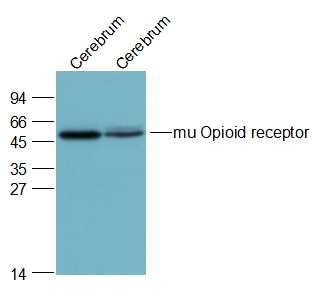 Sample:
Sample:
Cerebrum (Mouse) Lysate at 40 ug
Cerebrum (Rat) Lysate at 40 ug
Primary: Anti-mu Opioid receptor (bs-3623R) at 1/1000 dilution
Secondary: IRDye800CW Goat Anti-Rabbit IgG at 1/20000 dilution
Predicted band size: 45 kD
Observed band size: 47 kD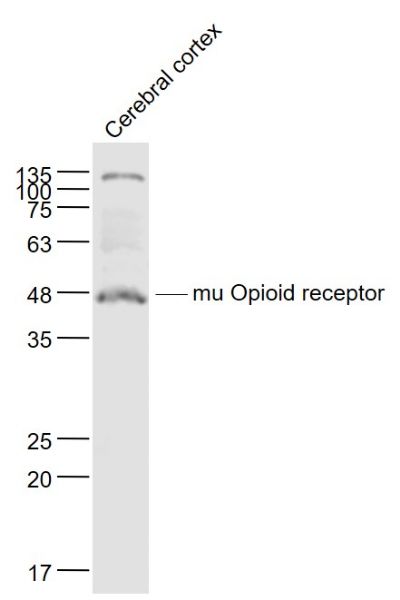 Sample:
Sample:
Cerebral cortex (Mouse) Lysate at 40 ug
Primary: Anti- mu Opioid receptor (bs-3623R) at 1/500 dilution
Secondary: IRDye800CW Goat Anti-Rabbit IgG at 1/20000 dilution
Predicted band size: 45 kD
Observed band size: 47 kD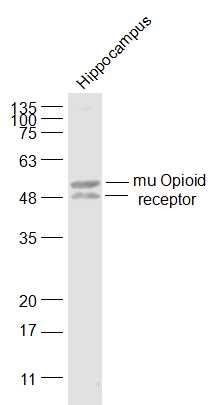 Sample:
Sample:
Hippocampus (Mouse) Lysate at 40 ug
Primary: Anti-mu Opioid receptor (bs-3623R) at 1/500 dilution
Secondary: IRDye800CW Goat Anti-Rabbit IgG at 1/20000 dilution
Predicted band size: 45 kD
Observed band size: 45/53 kD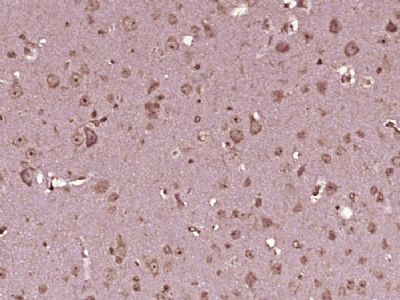 Paraformaldehyde-fixed, paraffin embedded (Mouse brain); Antigen retrieval by boiling in sodium citrate buffer (pH6.0) for 15min; Block endogenous peroxidase by 3% hydrogen peroxide for 20 minutes; Blocking buffer (normal goat serum) at 37°C for 30min; Antibody incubation with (mu Opioid receptor) Polyclonal Antibody, Unconjugated (bs-3623R) at 1:400 overnight at 4°C, followed by operating according to SP Kit(Rabbit) (sp-0023) instructions and DAB staining.
Paraformaldehyde-fixed, paraffin embedded (Mouse brain); Antigen retrieval by boiling in sodium citrate buffer (pH6.0) for 15min; Block endogenous peroxidase by 3% hydrogen peroxide for 20 minutes; Blocking buffer (normal goat serum) at 37°C for 30min; Antibody incubation with (mu Opioid receptor) Polyclonal Antibody, Unconjugated (bs-3623R) at 1:400 overnight at 4°C, followed by operating according to SP Kit(Rabbit) (sp-0023) instructions and DAB staining.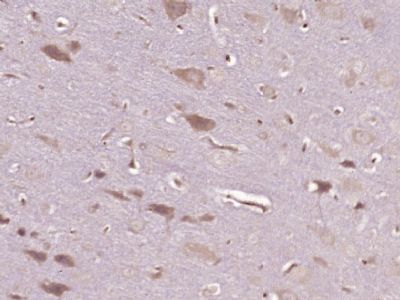 Paraformaldehyde-fixed, paraffin embedded (Rat brain); Antigen retrieval by boiling in sodium citrate buffer (pH6.0) for 15min; Block endogenous peroxidase by 3% hydrogen peroxide for 20 minutes; Blocking buffer (normal goat serum) at 37°C for 30min; Antibody incubation with (mu Opioid receptor) Polyclonal Antibody, Unconjugated (bs-3623R) at 1:400 overnight at 4°C, followed by operating according to SP Kit(Rabbit) (sp-0023) instructions and DAB staining.
Paraformaldehyde-fixed, paraffin embedded (Rat brain); Antigen retrieval by boiling in sodium citrate buffer (pH6.0) for 15min; Block endogenous peroxidase by 3% hydrogen peroxide for 20 minutes; Blocking buffer (normal goat serum) at 37°C for 30min; Antibody incubation with (mu Opioid receptor) Polyclonal Antibody, Unconjugated (bs-3623R) at 1:400 overnight at 4°C, followed by operating according to SP Kit(Rabbit) (sp-0023) instructions and DAB staining.

